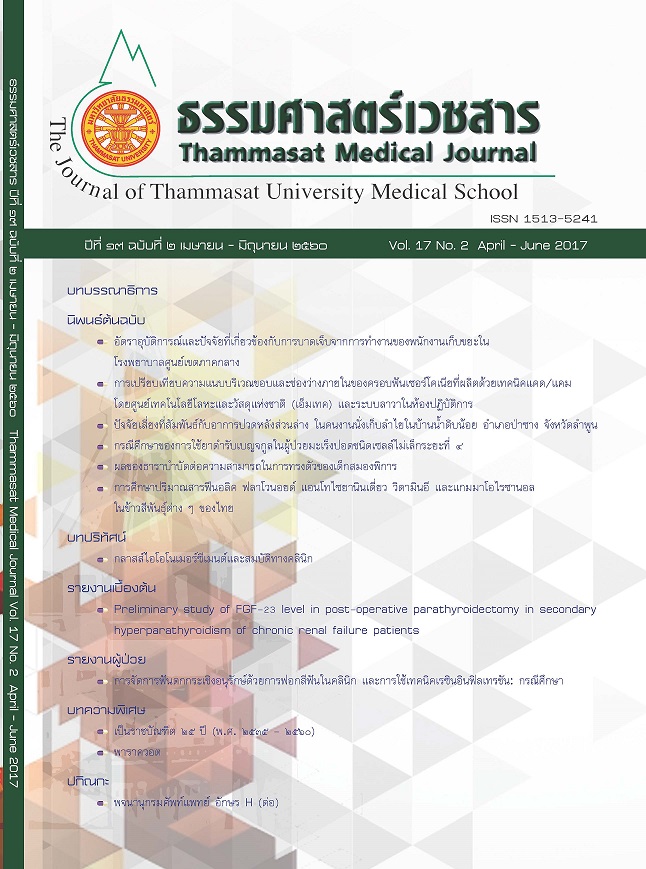Study on total phenolics compound, total flavonoids, total monomeric anthocyanins, vitamin E and gamma-oryzanol in pigmented Thai rice
Keywords:
ข้าวสี, คุณค่าทางโภชนาการ, ข้าวเหนียวดำ, Pigmented rice, Nutritional value, Black glutinous riceAbstract
Introduction: There are many indigenous varieties of rice in Thailand and various colors of rice pericarp. Pigmented rice is known to have higher bioactive compounds than white. This research aimed to determine which pigmented rice variety had the highest number of bioactive components.
Method: This study assessed the level of total phenolics compound, total flavonoids, total monomeric anthocyanins, vitamin E and gamma-oryzanol in fifteen varieties of half-milled rice. The red to dark-red (n = 7) purple to black (n = 5) and white (n = 3) rice varieties were collected throughout Thailand.
Result: The total phenolics compound in all varieties of rice ranged from 0.27 to 1.63 milligram GAE (gallic acid equivalent)/gram. On average, there was more phenolics compound present in purple to black varieties versus the red to dark red and white. The level of total flavonoids varied from 28.87 to 111.89 microgram RE (rutin equivalent)/gram. Total monomeric anthocyanin was found only in purple or black rice: 11.97 to 558.68 microgram/gram. We also discovered there was more that anthocyanin in glutinous than normal rice. Gamma-oryzanol in all samples was 238.49 to 1460.38 microgram/gram). Vitamin E was noticeably higher in black rice and some kinds of deep red rice from 25.91 to 43.38 microgram/gram.
Discussion and Conclusion: Niew Leum-Pua was the darkest, smallest grain of all the half-milled varieties, but it demonstrated the highest bioactivity. Our research indicates Niew Leum-Pua cultivation should be promoted in Thailand due to its potential disease preventive as shown with bioactivity and high nutritional value.
บทนำ: สายพันธุ์ข้าวไทยมีความหลากหลายทางพันธุกรรม เยื่อหุ้มเมล็ด (ผิวข้าวกล้อง) ของข้าวก็มีหลากหลายสี และยังพบว่าข้าวที่มีเยื่อหุ้มเมล็ดสีเข้มมีปริมาณสารออกฤทธิ์ทางชีวภาพสูงกว่าข้าวขาว การศึกษาครั้งนี้จึงมีวัตถุประสงค์เพื่อศึกษาหาพันธุ์ข้าวสีในประเทศไทยที่มีปริมาณสารออกฤทธิ์ทางชีวภาพต่าง ๆ มากที่สุด
วิธีการศึกษา: งานวิจัยนี้ได้รวบรวมข้าวทั้งหมด ๑๕ พันธุ์ โดยแบ่งเป็นข้าวสีแดง-แดงเข้ม จำนวน ๗ พันธุ์ ข้าวสีม่วงดำ จำนวน ๕ พันธุ์ และข้าวขาวจำนวน ๓ พันธุ์ จากแหล่งต่าง ๆ ทั่วประเทศ แล้ววิเคราะห์เปรียบเทียบปริมาณสารฟีนอลิคทั้งหมด ฟลาโวนอยด์ทั้งหมด แอนโทไซยานินเดี่ยวทั้งหมด วิตามินอีและแกมมาโอไรซานอล
ผลการศึกษา: พบปริมาณฟนี อลิคทัง้ หมดในข้าวทุกพนั ธุ์ ตั้งแต่ ๐.๒๗ ถงึ ๑.๖๓ มิลลิกรมั GAE (gallic acid equivalent)/กรัม(ข้าวกล้อง) โดยปริมาณฟีนอลิคทั้งหมดเฉลี่ยในข้าวพันธุ์สีม่วง-ดำจะมีมากกว่าพันธุ์ข้าวสีแดง-แดงเข้มและในข้าวขาว พบปริมาณฟลาโวนอยด์ทั้งหมดในข้าวตั้งแต่ ๒๘.๘๗ ถึง ๑๑๑.๘๙ ไมโครกรัม RE (rutin equivalent)/กรัม(ข้าวกล้อง) พบปริมาณแอนโทไซยานินเดี่ยวเฉพาะในข้าวสีม่วง-ดำเท่านั้น ตั้งแต่ ๑๑.๙๗ ถึง ๕๕๘.๖๘ ไมโครกรัมต่อกรัม (ข้าวกล้อง) และพบในข้าวเหนียวมากกว่าข้าวจ้าว พบปริมาณแกมมาโอไรซานอลในข้าวทุกพันธุ์ตั้งแต่ ๒๓๘.๔๙ ถึง ๑๔๖๐.๓๘ ไมโครกรัมต่อกรัม (ข้าวกล้อง) และพบปริมาณวิตามินอีในข้าวทุกพันธุ์แต่จะมีมากในข้าวสีม่วง–สีดำและในข้าวสีแดง–สีแดงเข้มบางพันธุ์ ตั้งแต่ ๒๕.๙๑ ถึง ๔๓.๓๘ ไมโครกรัมต่อกรัม (ข้าวกล้อง)
วิจารณ์ และสรุปผลการศึกษา: ข้าวเหนียวลืมผัวจะมีสีดำเข้มมากที่สุดและเมล็ดข้าวกล้องมีขนาดค่อนข้างเล็กทำให้มีปริมาณสารออกฤทธิ์ทางชีวภาพต่าง ๆ มากที่สุด ดังนั้นควรส่งเสริมให้มีการเพาะปลูกข้าวพันธุ์เหนียวลืมผัว อีกทั้งแนะนำให้บริโภคหรือนำไปประยุกต์เป็นผลิตภัณฑ์ส่งเสริมสุขภาพและป้องกันโรคได้ด้วยตนเองได้


